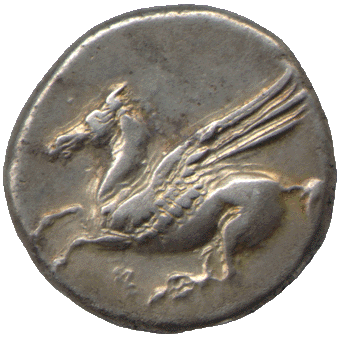
Pegasus has been a very popular theme for art since the time of ancient Greece. He appears on the coinage of Corinth and other Greek city - states as well as the coins of several Roman emperors. He has been a symbol of strength, swiftness, and the special bond between a man or woman and a favorite horse from ancient times until the present. Coins bearing the image of Pegasus are quite popular today amongst both collectors and those who just want to own a piece of ancient art and history. Coins of the Roman emperor Gallienus are quite reasonably priced, with a nice specimen selling for about twenty - five to thirty - five dollars. This Corinthian stater is a bit more expensive at about two hundred seventy five dollars, as Greek silver coins generally command a premium in nice condition. This example has a diameter of about 22mm and is a bit thicker than a U. S. nickel.
The coin is listed in David Sear's Greek Coins and their Values Vol. I Europe as s2629.